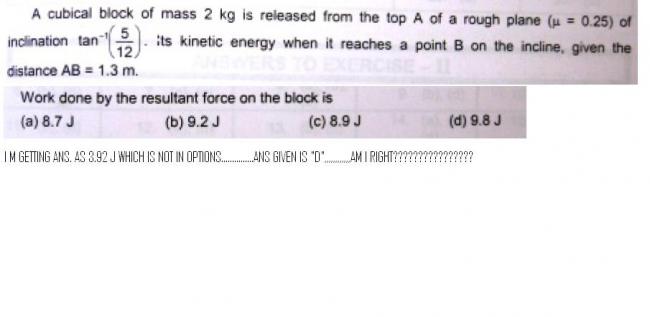 1
1Well got the answer.............
acceleration of the block=(5g/13)-(0.25)12g/13
=2g/13
v2-u2=2as
v2={4g(1.3)/13}+0
Its KE when it reaches B is (1/2)mv2=16J
Its initial energy, PE=mgh=2g(1.3) = 26J
So the work done = 10J......
Mark my mistake in the previous post(#2)
If U take g=9.8,
KE at B = 15.37
PE at A =25.48 wrt B
Work done = 10.11 J
I din get 3.92 ...[2][4]
 1
1I am getting the answer as 10
 1
1Is the answer option D as given in the book ? Only Jamesbond can answer it.
 3
3i am sure ans wont be 4.
u guys havent taken into account dat friction is a non conservative here it is specific.
 3
3i am saying this thing for two years.
that is the actual work done by friction will be greater than wat we find.
acc to me its not mu (mg cos (theta))xdisplacement
which holds only when the block is very slowly moved.As the energy lost as sound or heat can be neglected.
 1
1Arrey I got 10,
And there is a Huuuge difference between 3.92 and 10
They R not the same thing!!!
So worrying[3]
 24
24whats the diff b/w 3.92 and 4 ???
they are the same thing.....
so why worrying ??
 1
1Well I have been waiting for developments over this thread,
I never got W=3.92, considering W=^ Energy
Could someone tell me the fate of this problem??
 1
1acceleration of the block=(5g/13)-(0.25)12g/13
=2g/13
v2-u2=2as
v2={4g(1.3)/13}+0
Its KE when it reaches B is (1/2)mv2=4J
Its initial energy, PE=mgh=2g(1.3) = 26J
So the work done = 22J......
Well............ I dont know!!![3]
 24
24@james.
if 3 guys are getting same anmswer....then u should accept that ans...
book may be wrong..[1]
 106
106yeah even i got 3.92J ... this is correct,
 1
1SO SHOULD WE ACCEPT 3.92 AS RIGHT ANSWER?????
 1
1IN QUESTION ITSELF I WROTE THAT I M GETTING 3.92 J :)
 24
24is the Kinetic energy asked or work done by resultant forces or both ???? in the questin
